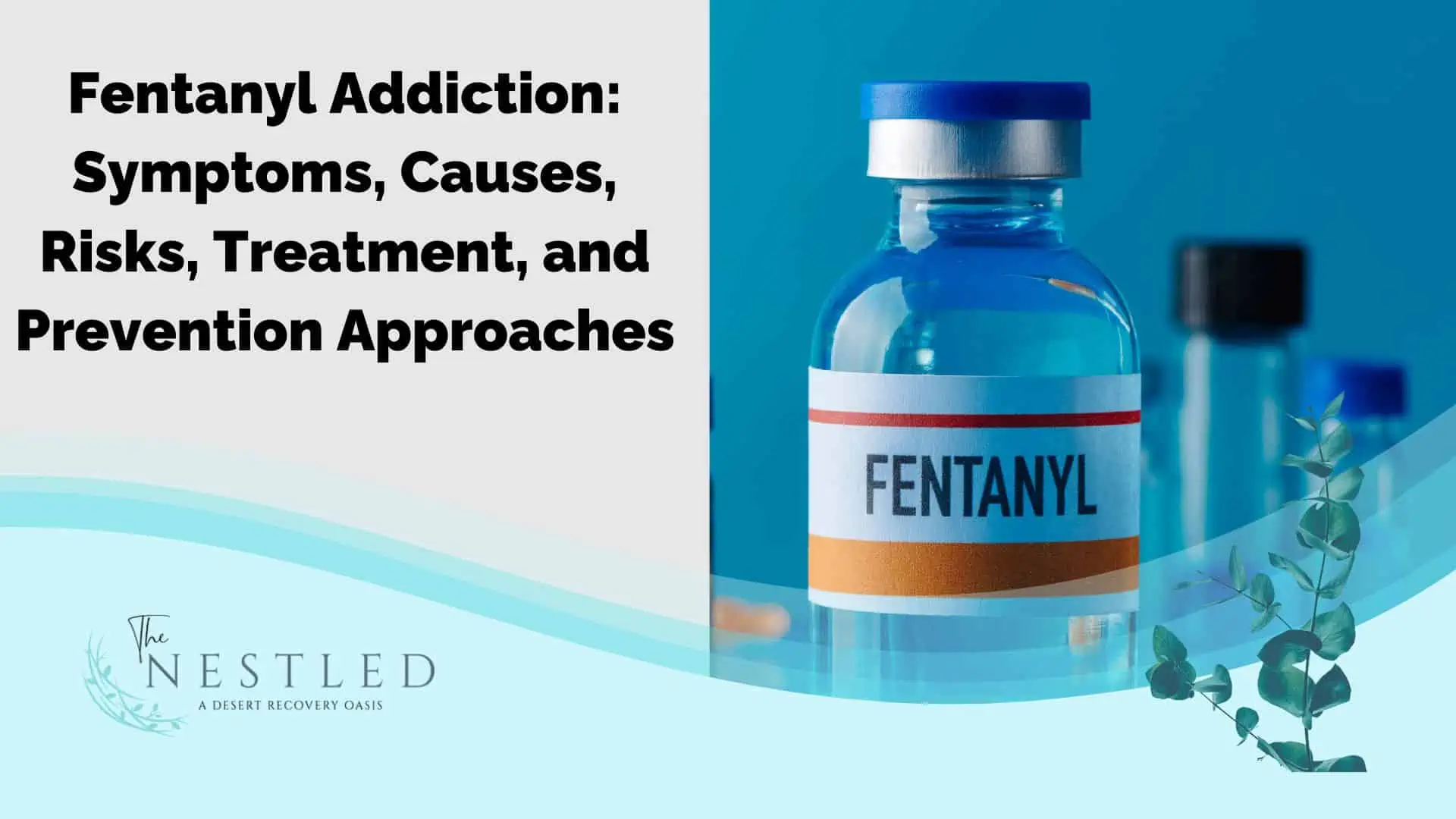Fentanyl addiction is an intense urge to use the fentanyl despite the dire negative effects it has on the user’s health and overall well-being. According to the National Institute of Drug Abuse’s 2022 Substance Abuse and Mental Health Services Administration, SAMHSA research, 991,000 individuals over the age of 12 abuse fentanyl.
Fentanyl is a highly potent synthetic opioid used medically for severe pain but has a high potential for addiction and misuse, leading to physical dependence and severe health risks.
Symptoms of fentanyl misuse include behavioral changes such as withdrawal from social activities, physical signs like drowsiness and confusion, and cognitive effects such as mental slowness and forgetfulness.
Causes of fentanyl addiction range from abusive use of prescribed painkiller opioids and genetic predisposition to environmental exposure and depression.
Treatment for fentanyl addiction involves medication-assisted treatment (MAT), which include drugs like buprenorphine or methadone, alongside therapies like cognitive behavioral therapy to manage withdrawal symptoms and support long-term recovery.
What Is Fentanyl Addiction?
Fentanyl addiction is a prolonged use or abuse of the opioid fentanyl characterized by an insatiable craving for the drug despite its negative repercussions. It’s a mental health disorder that can wreak havoc on an individual’s life, which makes understanding and addressing fentanyl addiction a priority.
Fentanyl, a synthetic opioid pain medication, serves as a relief for those struggling with severe pain, such as post-surgery or advanced cancer patients. Its potency, surpasses that of heroin by 50 times and morphine by 100 times.
This potency contributes to its effectiveness as one of the opioid analgesics to treat severe pain. Yet, this same potency also harbors a potential pitfall, paving the way to a grim addiction to fentanyl and other opioids. The pleasure derived from fentanyl use, coupled with its potency, can rapidly ensnare individuals in the cycle of addiction.
How Addictive Is Fentanyl?
Fentany is highly addictive. According to the Centers for Disease Control and Prevention, CDC’s Substance Abuse and Mental Health Administrators 2022 research data, fentanyl abuse accounts for 19 percent of all substance abuse in the United States.
Fentanyl misuse is far from an isolated occurrence. It’s a pervasive problem that continues to escalate. Statistics from the National Institution of Drug Abuse NDIC show that overdose deaths involving synthetic opioids, predominantly fentanyl, witnessed a staggering increase of over 22% from 2020 to 2021, with a reported 70,601 overdose deaths in 2021.
The pathway to fentanyl dependency usually starts with legal prescription opioid use. As tolerance develops, individuals often seek out more potent illicit opioids, including fentanyl. This transition underscores the risks of prescription opioid misuse.
Research from drug abuse statistics NCDAS shows that more than 20 million Americans from the age of 12 have fentanyl addiction, and 20 percent of people with substance abuse issues use fentanyl. The COVID-19 pandemic further exacerbated the issue, leading to an acceleration of fentanyl-related overdose deaths.
These alarming statistics mirror the devastating impact of the pandemic on substance abuse trends.
What Are The Symptoms Of Fentanyl Addiction?
Symptoms of fentanyl addiction show in various ways, including distinct behavioral changes, physical indications, and cognitive and psychosocial effects.
- Behavioral Indicators
The destructive grip of fentanyl addiction often leads to noticeable behavioral changes. These changes can manifest in various forms, including withdrawal from family and friends, shifts in social circles, and decreased involvement in hobbies and activities that were once enjoyed.
Individuals addicted to fentanyl experience mood swings, episodes of irritability, nervousness, and giddiness. The tendency to isolate themselves increases, and the addicts exhibit secretive behavior, indicating a possible struggle with substance abuse. These behavioral symptoms, although subtle, are critical in early detection of fentanyl abuse.
- Physical Symptoms
Fentanyl addiction is characterized by specific physical symptoms, which include:
- Extreme happiness
- Drowsiness
- Nausea
- Confusion
- Constipation
Its addiction poses immediate health risks. Pronounced sedation and significant problems with breathing may occur, even when the drug is used as prescribed. Identifying these physical symptoms is key to detecting potential fentanyl abuse and seeking timely intervention.
- Cognitive And Mental Effects
The negative effects of fentanyl abuse aren’t limited to physical symptoms. It can also lead to cognitive impairments, such as mental slowness and forgetfulness, resulting in functional disabilities and a reduction in quality of life.
Fentanyl addiction is associated with an increased risk for mental health issues such as anxiety and depression, further contributing to a lower quality of life. While medication-assisted treatment for addictive disorders tends to improve cognitive outcomes, cognitive performance may still be impaired when compared to non-substance users.
What Are The Risk Factors Of Fentanyl Addiction?
A multitude of risk factors influence fentanyl dependency, they include the following;
- Genetic Predispositions
Genetic predispositions, such as variations in genes related to the opioid system, increases the chances of an individual’s risk of becoming addicted to opioids like fentanyl.
Other factors that can increase the risk of fentanyl addiction include:
- Family history of substance addiction
- Genetic factors
- Environmental influences, such as experiencing abuse, exposure to caretakers with substance use disorders, and residing in poverty-stricken or rural areas
The risk of getting addicted on fentanyl increases even when it is taken as prescribed, setting the path toward addiction. Patients who are already tolerant to other prescription opioids have an increased risk of dependence when prescribed fentanyl as a stronger alternative for managing chronic pain.
Furthermore, mental health disorders or physical disorders, as well as exposure to trauma, often act as triggers towards fentanyl dependency.
What Are The Effects Of Fentanyl Addiction?
The dangers of fentanyl abuse are numerous and pose immediate health risks and long-term consequences.
Immediate Health Risks
Fentanyl abuse increases the risk of an overdose. An overdose increases the chances of respiratory depression, where breathing can slow or stop, resulting in hypoxia—an inadequate oxygen supply to the body tissues.
In severe cases, fentanyl overdose can lead to:
- Unconsciousness
- Coma
- Permanent brain damage
- Death
Given the high addictive nature of fentanyl, an opioid overdose is a medical emergency that requires prompt intervention to prevent fatal outcomes.
Long-Term Consequences
While the immediate health risks of fentanyl abuse are alarming, the long-term consequences are equally devastating. Chronic fentanyl addiction can lead to:
- The development of tolerance necessitates higher doses to achieve the same effects
- Significant rise in the risk of overdose
- A spectrum of long-term health complications
- Suppress immune functions
- Contribute to hormonal and reproductive difficulties
- Increased risk of co-occurring disorders
- Add complexity to the user’s mental health challenges
- Complicate treatment efforts.
Untreated fentanyl addiction eventually affects various aspects of the user’s life, resulting in diminished overall physical and mental functioning. It also exposes the individual to a higher risk of diverse health issues.
What Are The Symptoms Of Fentanyl Withdrawal?
The effects addicts feel when they quit the use of fentanyl experiences is called fentanyl withdrawal. Symptoms of fentanyl withdrawal include the following:
- Muscle and bone pain
- Sleep problems
- Diarrhea
- Vomiting
- Cold Flashes
- Uncontrollable leg movements
- Severe cravings
Medication-assisted treatment (MAT) can alleviate withdrawal symptoms and reduce fentanyl addiction cravings. These medications include the use of drugs such as buprenorphine, methadone, and clonidine. Monitoring the severity of withdrawal symptoms using tools like the Short Opioid Withdrawal Scale (SOWS) can help adjust management strategies accordingly.
Maintaining a calm environment, sidestepping forced physical exercise, and ensuring round-the-clock availability of healthcare workers are also key elements for successful withdrawal management.
How Do I Respond To Fentanyl Overdose?
A swift and appropriate reaction to fentanyl overdose can mean the difference between life and death, but first, you have to recognize fentanyl overdose. Symptoms of fentanyl overdose include:
- Unconsciousness
- Severely reduced breathing or no breathing
- Limp or rigid body
- Choking sounds
- Tiny pupils
- Pale or bluish skin
The response to an overdose includes:
- Calling 911 or other paramedic services
- Administering naloxone
- Maintaining the person’s airway
- Laying them on their side
- Remaining with them until help arrives
Naloxone used to reverse opioid overdoses, may require multiple administrations, especially with potent opioids like fentanyl, to counteract the strong effects.
Thankfully, Good Samaritan laws provide legal protection to those who assist in an overdose emergency and to the person overdosing, potentially encouraging more bystanders to help without fear of legal repercussions.
What are the Treatment for Fentanyl Addiction?
While overcoming fentanyl addiction might seem daunting, it is certainly achievable with the right treatment approach.
- Medication-assisted treatment; Medication-assisted treatment (MAT) combines medications like methadone, buprenorphine, and naltrexone with counseling and behavioral therapies to treat the disorder.
- Behavioral therapies; Behavioral therapies, such as cognitive behavioral therapy, contingency management, and motivational interviewing, are effective in treating fentanyl addiction, particularly when used alongside medication.
It’s important to remember that treatment duration with MAT is not capped and may continue indefinitely to meet the long-term recovery needs of the individual.
In what ways do social and environmental factors contribute to the development and maintenance of both fentanyl addiction and lorazepam addiction?
Social and environmental factors significantly influence the development and perpetuation of fentanyl addiction and lorazepam addiction. Access to prescription medications, peer influences, socioeconomic status, trauma history, and availability of mental health support all contribute to individuals’ susceptibility to addiction. Whether obtained through prescriptions or illicit means, exposure to these drugs can be facilitated by social networks and environmental stressors.
Are there potential drug interactions or adverse effects when fentanyl is abused concurrently with cocaine?
Both fentanyl, a potent opioid, and cocaine, a stimulant drug substances exert contrasting effects on the central nervous system, with fentanyl suppressing respiratory function and cocaine increasing heart rate and blood pressure. Concurrent use of fentanyl and cocaine, known as a “speedball,” can result in a complex interplay of physiological effects, including heightened risk of cardiovascular complications, respiratory depression, overdose, and death.
How Does Fentanyl Affect Your Vitals?
Fentanyl can cause a decrease in myocardial oxygen consumption and coronary blood flow, as well as a decrease in cardiac output, heart rate, respiratory rate, and arterial oxygen tension at higher plasma concentrations. This indicates a significant impact on vital signs.








